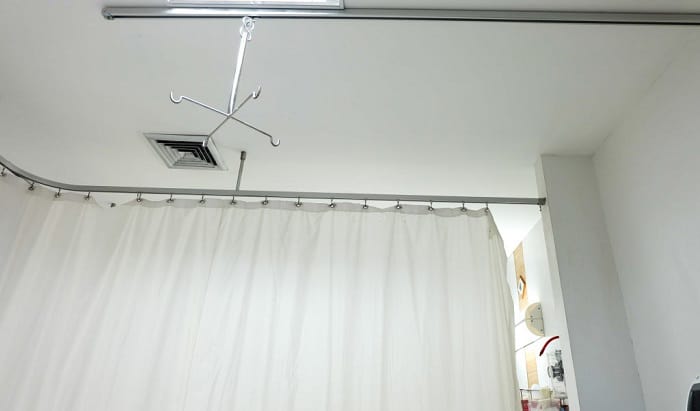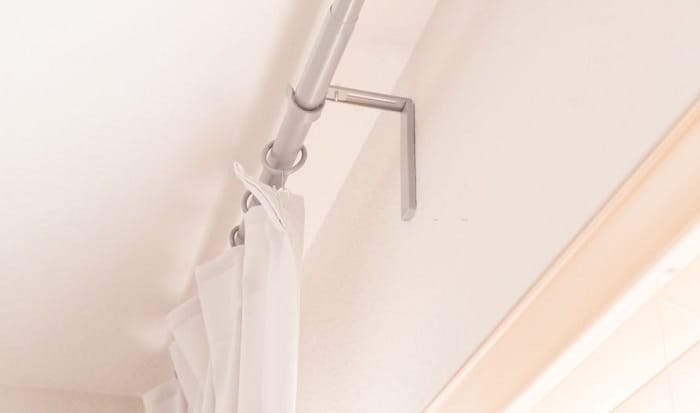How Much Weight Can a Tension Rod Hold? Get the Facts Here!
You can get various types of curtains, from ones with warm natural models to others with rich textures, if your house is looking for a fashionable makeover. A tension rod is the typical item to ... Read more The post How Much Weight Can a Tension Rod Hold? Get the Facts Here! appeared first on Arthitectural.


You can get various types of curtains, from ones with warm natural models to others with rich textures, if your house is looking for a fashionable makeover. A tension rod is the typical item to hang those curtains. In many homes nowadays, they are used to hold even the heaviest drapes and other things in the house. Nevertheless, not all tension rods are suitable for whatever you want to hang.
In this article, you will find detailed information on how much weight can a tension rod hold to choose the right one that meets your requirements. Let’s explore four varieties of rods with different weights and use.
- Tension rod, what is it?
- Tension rod weight limit
- Tension rod usage
- Benefits and drawbacks of tension rods
Tension Rod, What Is It?

A tension rod is a bar that is put between two walls, windows, or some hard surfaces to ensure that the rod is in position. You need to stretch the rod between the two surfaces to support itself and hang a shower or window curtain, clothes, etc. It is generally flexible in length and can be securely attached without drilling holes. It is also usually equipped with rubber on both ends to keep the surfaces from scrapes.
To effectively use the tension rod, it must be placed between two solid and flat surfaces facing each other, such as the gap between two window frames or closet walls. Measure the distance between the two surfaces with a tape to determine how long your rod will be. Before you install one, make sure that the surface can withstand the rod’s pressure. It generates strain on an area where you put it. So, it’s probably good for a concrete surface, but perhaps not a painted drywall.
Tension Rod Weight Limit
When you stretch tension rods, they lose their strength. In other words, they will not be able to bear up much weight if you extend them to their maximum length. You should, thus, choose one that is longer than you require when it is completely extended. For instance, if your space is 60 inches (150 cm), your rod needs to be up to 84 inches (210 cm).
Inspect your rod’s weight limit too. You need something with a bigger capacity if you’re going to hang heavy objects. It is not a weight-bearing tension rod like other kinds including a tension closet rod because of how it is put. A tension rod can hold 20 pounds (about 9 kg) on average. After you know what to use and where to install, it’s time to select the right one. Four types of tension rods are listed below.
Spring tension rod
A spring tension rod comprises two rods with two capped ends. One rod is smaller than the other. The small rod fits the big one and compresses a spring inside. A spring tension rod is relatively small and can be adjusted from 28 to 48 inches (71 to 121 cm), meaning that it can handle the lightest weight compared to others. The maximum weight that this rod can hold is between 10 and 15 pounds (4.5 kg to 6.8 kg).
What you hang and what materials are there will be extremely important. A tension spring rod is an excellent choice for hanging lightweight objects, including shower curtains and blinds in the window frame. Spring tension rods are also the most affordable option.
Aluminum rod
The most frequent rod you may find in houses is an aluminum tension rod. Although some aluminum rods are strong enough to keep heavy clothes, they are mainly used for hanging shower curtains. The extendable shower tension rod may be attached to a range of shower widths between 58 and 72 inches (from 147 to 183 cm).
An aluminum shower curtain rod can hold about 20 pounds (approx. 9 kg), which is the standard weight limit. Even though they are not small tension curtain rods, it’s not recommended to hang many clothing items because they are not meant for this reason in general. The typical tension rod is made of metal, which can be broken when hanging too many clothes and wet laundry.
Heavy-duty tension rod
A heavy-duty tension rod will be a perfect choice to hang thicker blackout curtains. It can hold much weight without the need for tools or drills on the walls. Heavy-duty tension rods with an additional support central bracket accommodate roughly 30 pounds (around 13 kg), leading to an even smaller chance of falling than the other two.
You might also install heavy-duty tension rods for closets, apart from heavy shower curtains. You don’t have to worry about this kind of shower rod as much as you would with the spring and aluminum ones since it’s a strong tension rod. Since it’s endurable and easy to install, it is typically used in numerous rental apartments.
Stainless steel tension rod
Stainless steel tension rods can withstand a lot of weight because they are made from steel. Most can handle up to 45 pounds (20 kg), twice the standard capacity of 20 pounds. These rods work well regardless of the weight you put on them. Besides their high cost and numerous functions, they can be utilized for nearly all purposes, such as hanging clothes, showers, and window curtains.
Tension Rod Usage

Although their lengths and load-bearing limitations are different, they can be set up in a few minutes. Tension rods are cost-effective equipment for curtain hanging. But if you simply use them to set up shower or window coverings, you will miss tons of additional applications. These are some clever ideas for using curtain rods in many areas of the house.
Room dividers
A room divider is a display or a piece of furniture that splits a room into different zones. Generally, a tension curtain rod is an excellent choice for room dividers because of its convenience and simplicity of installation.
If you live in a studio apartment, you may use it to hide your bed and make it seem separated. It can also be used in installing the drapes of a high bunk bed in children’s rooms and dormitories for privacy.
Hang clothing items
A tension rod can hold air-dry laundry as a clothes rack and newly ironed clothes in wardrobes to avoid wrinkles. When choosing a tension rod for hanging clothes, it is vital to know if it’s for a toddler or a grown-up closet. Children’s clothing is not as heavy as that of adults, therefore, you don’t need to buy the steel type that costs more money.
Furthermore, put high heels on a tension rod as a shoe rack and arrange them in an orderly way if you or your family has a collection of shoes that consumes a lot of space in the wardrobe. This tension shelf technique works very well within the closet or in a dressing area.
Store accessories
It’s possible to hang your jewelry and small accessories, such as necklaces, bracelets, earrings, or handbags on the tension rod. To make it more organized, you can use some hooks as well. Hooks make it easier to remove and change items, as you will not have to take the bar away from the wall.
Kitchen holder
It is difficult to keep your equipment in your kitchen cabinets organized, especially if the sizes are diverse, but this is where tension rods can help. Place some of them above the sink and stove to easily access kitchen utensils. Install a few rods in the cabinet to help plates, pans, pots, pot lids, chopping boards, and trays stand nicely. You may also hang up your cups and create a coffee zone by using some hooks.
Organize detergent
It’s not surprising that most under-sink cabinets are messy because cleaning products are usually ignored. But it’s not difficult to handle this situation. All you need is to fix a tension rod between the two walls in the cupboard and hang up the spray bottles when it has been attached tightly.
It also clears up space on the floor for other cleaning products. It not only makes your kitchen cleaner and larger but also allows you to see the cleaners immediately.
Hold bathroom accessories
Measure a tension rod that is equivalent to your bathtub’s length and put it along with the bathroom. After that, hang some small plastic containers on the rod to organize bathroom supplies like shampoo, body wash, or bathtub toys. This easy hack is a time-saver and an appealing solution to bath toy messes.
Herb garden hanger
Finally, tension rods work well for hanging herb gardens if you don’t have enough sunshine to flourish your indoor plants, particularly sun-loving plants and flowers. It’s time to upgrade any window into a stylish herb garden with only a rod and S-hooks. Fix the rod into the frame and place the plant pots on it. Other than the sunlight advantage, they can stop your pets from destroying your pots.
Benefits And Drawbacks Of Tension Rods
As mentioned, tension rods hold nearly everything from cooking to gardening in the house. However, they have both positive and negative sides. The advantages and disadvantages of a tension rod are connected directly to the way it is placed and its weight capacity. Let’s look at some of the primary benefits and drawbacks a tension rod can offer.
Benefits
- Easy to set up: A tension rod is a simple method to hold light curtains and separate spaces. These low-cost rods are highly adaptable and may be used almost everywhere in your home to store and arrange things. You can simply attach it between two walls with one pull and twist.
- No drilling required: The installation of tension curtain rods requires no equipment and does not damage walls because the tension on the walls stabilizes the rod.
- Affordable: Tension rods are generally much cheaper than other types of curtain rods. For around $10, you can get a basic one.
- Suitable for temporary usage: Tension rods might be a wonderful choice if you rent an apartment since screws are not necessary to mount the rod to the walls. This will assist you in installing your curtains quickly and save you from fixing the walls later.
Drawbacks
- Not very sustainable: It is less stable than the permanently mounted curtain rod. In other words, a tension curtain rod is more likely to collapse or be removed, which might be dangerous to families with kids.
- Create marks or cracks: Even though both ends of the bar are equipped with rubber for protecting the wall, they might still leave scars. Drywall’s material is more prone to crack and get damaged when enduring the high pressure from the rod.
- Limited spaces: Two surfaces must be close enough to place a rod tightly. Your curtains will fall off if the rod doesn’t fit closely enough.
Conclusion
If you are unaware of how much weight can a tension rod hold, you may unintentionally cause harm to your wall and probably your family members. Through this post, you have learned about the different weight capabilities of tension rods and some creative ideas for their practical usage.
Take note that an average tension rod can hold up to 20 pounds to select one that fits you most. Was this article helpful for you? If yes, leave your opinions in the comments and share them with your family and friends.
The post How Much Weight Can a Tension Rod Hold? Get the Facts Here! appeared first on Arthitectural.
